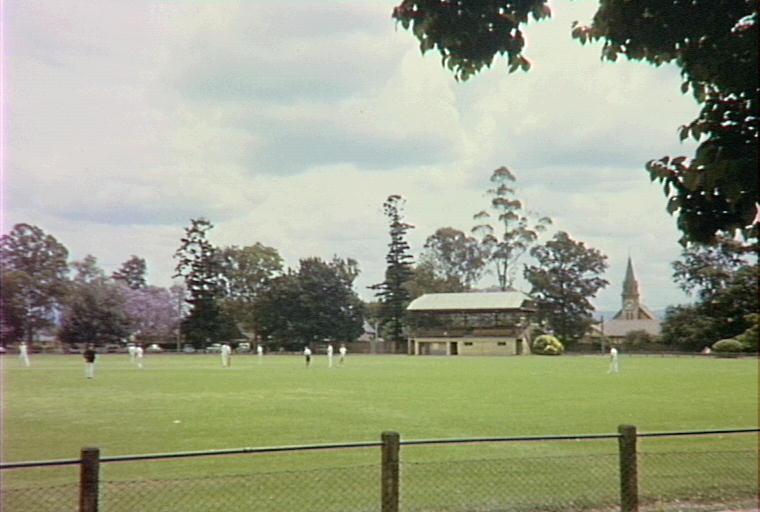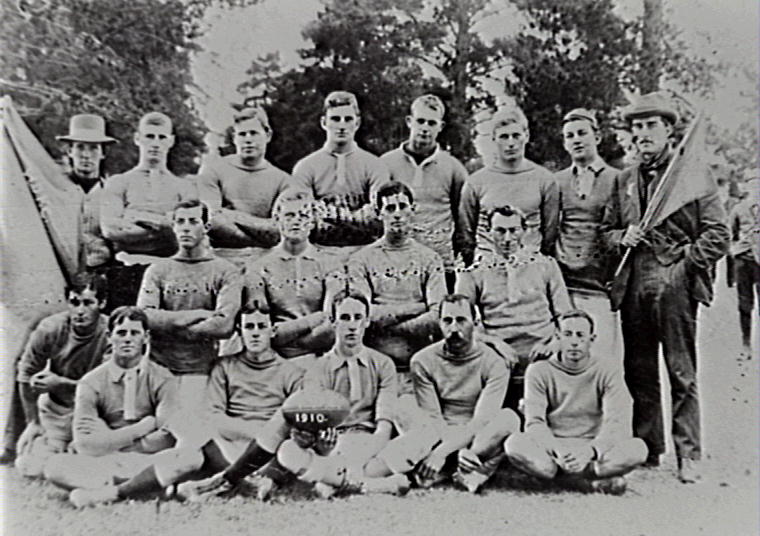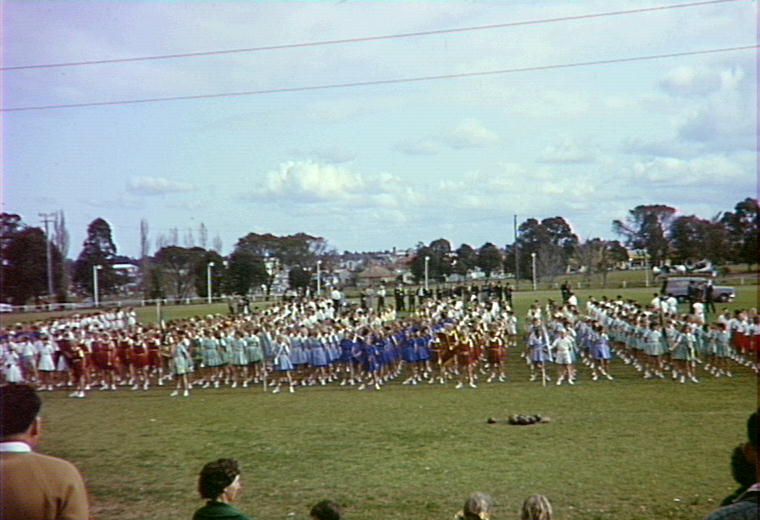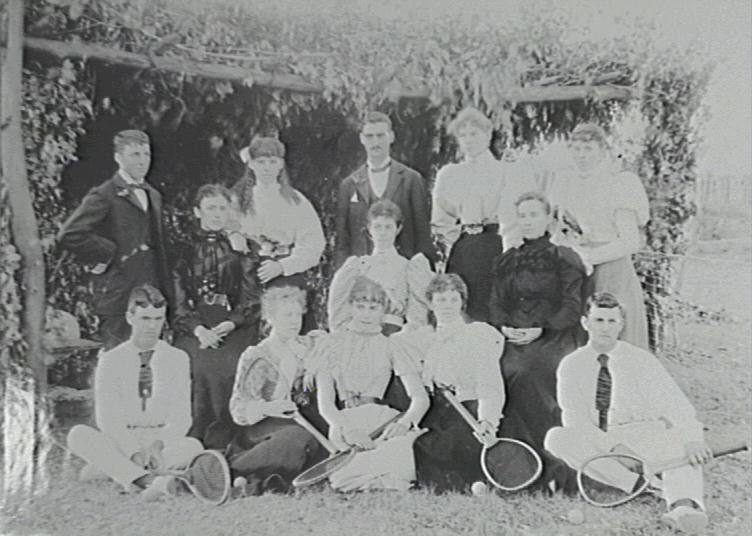In previous centuries, recreation and leisure time in the Hawkesbury was constrained due to working commitments and economic factors. The residents of the district created their own activities which included a wide range of sporting pursuits and recreational entertainment.
Sport:
The Hawkesbury district as always been very involved in the pursuit of sport. Some of the most popular sports include :-
Horse breeding & racing
Breeding horses and horse racing has always been very popular in the Hawkesbury district. A map dated in 1806 mention a "Race Course" and an early account reports of a race in 1810 at in Windsor. "Mr Benn's Scratch was matched against Mr May's roan poney (sic) formerly Mr Williamson's, to run two miles for a sum said to be considerable".Scratch was the winner. Regular races were held throughout the Hawkesbury district including : Killarney, near McGraths Hill, Clarendon, Wilberforce & North Richmond. The first organised meet took place in 1829.
In 1865 the Hawkesbury Race Club was established. Crown Land at was leased to the Club and grandstand and racetrack built. The first Hawkesbury Grand Handicap was run in 1871 with a purse of 120 sovereigns.
Cricket
Cricket has been played in the Hawkesbury district since the early 19th century. In 1882 a match between the visiting All England Eleven was played against a team selected from players from the Hawkesbury & Nepean. A special train conveyed about 1000 additional spectators to Windsor. The home team scored 61 with All England replying with 5 for 135. Charlie Nicholls of Freemans Reach was renowned as one of the finest players in the Hawkesbury.

Local cricket at Richmond Park in the 1950s
Source : Hawkesbury City Council Library
Football
Various forms of football have been played in the Hawkesbury, including nameless games of kicking a ball around a field in the early 19th century. Rugby Union, which had been introduced from England in the 1860s, was the first type of football played in the late 19th century in the Hawkesbury. Rugby Union games were played in McQuade Park from at least 1896.

Windsor Football Club in 1910
Source : Hawkesbury City Council Library
Another code of football was introduced when a break away group Rugby League was set up in NSW in 1907. The first League team in Windsor was established by 1910. This was a very popular sport, particularly in the post World War 2 period, and the district won many premierships and produced many fine players. There are currently two major teams in the Hawkesbury district, the Windsor Junior Rugby League known as the "Windsor Wolves" and Hawkesbury City based in Richmond. The Windsor Leagues Club officially opened a licensed league club in South Windsor in 1986.
Australian Rules Football evolved in Victoria in the 1850-1860s. Mainly a Victorian game, eventually the code spread to NSW in the 20th century. The local team club is Hawkesbury Australian Rules Football Club.
Athletics
Various challenges were made during the 19th century by persons wishing to show off their athletic abilities. These included running races, rolling downhill in a barrel and running with a pumpkin on your head. One interesting chap was William Francis King who was known as the
"Flying Pieman"
Athletic days were held in local parks or wherever there was space. One particular event held in Richmond Park in 1881 included races, hurdles, sack races and a tug of war. A 50 yard backward race and even a race run on both your hands & feets. Schools promoted Athletics and a wide range of activities involving students took place. During the mid to late 20th century many combined school athletics days took place at Richmond Park & McQuade Park in Windsor.Ê
Sports Days and tea meetings were very popular in small communities and often held in Lower Portland, Bullridge and Currency Creek for the dual purpose of raising funds for local projects and for the entertainment of the community.
The community at Bullridge (also known as East Kurrajong) spent many years raising money to build a much needed School of Arts adjacent to Stanley Park. It was reported that "a nice gathering assembled at Stanley Park on Monday, 27th January, for the tea meeting. " Some of the proceeds were to go towards the project. A number of races were held including a bicycle race, flag race, and needle race. Apparently one lady cheated by having the needle already threaded but still failed to win the contest. Tests of strength were also included such as the wood chopping and ladies nail driving contest.
After the tea meeting, about 20 couples continued the festivities by engaging in music and dancing into the night. "About midnight refreshments were passed around. Dancing was kept going until 4 o'clock".
By 1922 the community at East Kurrajong had almost raised enough funds to build the School of Arts. The Windsor and Richmond Gazette of 3 February 1922 reported on a "Great Day's Sports" held on anniversary Day (26th January). This special days events included a pea-growers race, guessing the name of doll competition, bun-eating competition and old buffers race. The day raised over £163 towards the cost of the building. The day concluded in the usual fashion by music and dancing.
Today there are several organisations in the district promoting athletics for juniors including Kurrajong/Bilpin Little Athletics Centre & Hawkesbury City Little Athletics Centre.

School athletics carnival at McQuade Park Windsor in the 1950s
Source : Hawkesbury City Council Library
A wide range of other sporting activities took place in the Hawkesbury including bowls, skating, pugilism, tennis, cockfighting & ratting.
Tennis
Lawn tennis has been enjoyed by Australians since the 1870s. Although it was largely male dominated, females began playing the Hawkesbury district from at least the 1890s. Competition tennis commenced in the early 20th century and night competition tennis was also very popular. The lights were turned on in 1936 on courts near the old Presbyterian church in Windsor. One of the finest tennis players was William "Bill" Walker who won many state & national titles in the 1920-1930s. Today tennis is still very popular and played throughout the district at various locations. Richmond Tennis Centre is the largest site and many significant competitions are held here.
Wilberforce Tennis Team 1895
Source : Hawkesbury City Council Library
RATTING
This sickening diversion involved the placing a dog into a pit confined with and see how many the dog can kill in a certain time. A few examples from the local newspaper are as follows :
At Mr. F.
Douglas' pit on Saturday there was a large attendance to witness the ratting
contests. Mr. F. Douglas conducted the affair, and it passed off most
successfully. Following were the results:- The Sweepstakes - 5 rats each. Mr.
W. Phillips' Jack, 42sec; E. Yeo's Snapper, 48sec; J. Chandler's Jack
Forester, 49sec. There were 13 entries for the event. Sweepstakes - 3 rats
each. Mr. J. Wood's Dodger, 15sec; J. Geehan's Ted, 18sec; J. Chandler's Jack,
26sec. For this event there were ten entries.
Windsor & Richmond Gazette, 13-10-1888
Newspapers for the time also advertised that Rats were bought in any quantity, at 2d each, he also sold rats and Terriers. From Humphrey Douglas at the Royal Hotel, Windsor. Douglass also ran a Pit were Ratting took place.[1]
SKATING CARNIVAL
Mr Hesford's Skating Carnival on Monday evening was a decided success. The attendance was very good, the weather delightful for such exercise, and the costumes selected by those in attendance were pleasing in the extreme. The hall of the School of Arts was made to assume a brighter aspect than usual by the introduction of a large collection of Chinese lanterns, which were suspended from the ceiling, and made quite a pretty show.
Source: Windsor & Richmond Gazette, 22-9-1888
The Hawkesbury River
The Hawkesbury River played an important part in recreation and water sports. In 1845 the Hawkesbury Regatta Club was formed to encourage aquatic sports on the Hawkesbury River. Races were held for two and four oared boats, sculls and canoes. Aboriginals were encouraged to participate in the canoe races. Regattas were held regularly along the river and the Grono family were first-rate participants.
Sculling
The sport of sculling was flourishing throughout the world during the latter half of the 19th century, particularly in Australia and around the Hawkesbury-Nepean & Parramatta Rivers. Australians dominated the sport with large crowds of spectators. Peter Kemp (1853-1921) a local Hawkesbury sportsman went on and became the World Champion Sculler.
Tourism & the Hawkesbury River
Although individuals had been travelling the length of the Hawkesbury River since the early 19th century it was mainly used as a means of transport. It wasn't until the 1830-1850s that excursions for enjoyment took place. In 1874 world famous author Anthony Trollope (1815-82) published his travels in Australia and wrote about the remarkable Hawkesbury River comparing it very favourably to the Rhine in Europe. This was during a period where day trips and holidays were becoming more popular and more attainable to the people and people flocked to the Hawkesbury and adjoining Blue Mountains particularly for day trips. As the Hawkesbury was accessible by river and train it became a popular destination. Visitors often took the steamer from Sydney to Windsor via the Hawkesbury River and then caught the train home.
The Hawkesbury district remained a popular destination during the advent of the motor car and even now, in the 21st century many Sydneysiders, interstate & international visitors come to see the district.
Swimming
When the district was originally settled by Europeans, many drownings took place as the settlers were not familiar with the river or swimming. Several generations later these families swam in the river for recreation. Swimming featured as a sport from about the 1890s. In 1896 the Mile Championship of Australasia race was held at Windsor with contestants from interstate and New Zealand, the race was won by Percy Cavill.
In 1896 a "meeting of ladies desirous of forming a swimming club in Windsor" took place at the School of Arts. About 30 ladies attended the meeting & a "Mr. F. Collison moved, and Mr. H.R. Buttsworth seconded, on behalf of the ladies, That a ladies' branch of the N.S.W. Swimming Association be formed in Windsor." The following ladies were proposed as a committee:- Misses Becke, Linsley, Wood, Brancker, D. Walker, Barnett, M. Dunstan, Cobcroft, Ward, A. Dunstan, Callaghan, J. Tebbutt.
Swimming Clubs were formed to promote and teach the art of swimming. Richmond Pool was opened in 1963 and Windsor in 1971. Swimming in the Hawkesbury, Grose & Colo Rivers has always been a popular past time. Unfortunately swimming has not been promoted in the Hawkesbury River since the late 1980s with the advent of the Blue-Green algae problem.
Recreation
Hawkesbury residents were proficient at entertaining themselves. Whilst sporting events were popular in some areas, social activities such as theatre, dances and tea parties were exceedingly prevalent in others.
School of Arts & theatre groups
Dr John Dunmore Lang opened the Windsor School of Arts building in Thompson Square in 1862 while Sir Henry Parkes opened the Richmond School of Arts in 1866. Each of the original buildings were fitted with a library and hall. Other buildings were established in the smaller townships at later dates. The School of Arts provided locals with lectures, recitals, debates, public meetings, balls etc. Richmond School of Arts is still used for its original purpose and is the home of the Richmond Players, the local drama group which was established in 1952.
Church activities
Religion played an important role in the Hawkesbury district and the religious beliefs of the various denominations often influenced the lifestyle. Church services gave the inhabitants the opportunity to worship and the chance to interact socially. Related events such as fetes, tea parties, concerts and other activities provided Hawkesbury residents with various forms of recreation.
Associations, organisations, societies & groups
Organisations, societies & groups commenced in the Hawkesbury when groups of people got together for a single purpose. One of the earliest groups commencing in the district was the Hawkesbury Benevolent Society in 1819, set up to support the poor, sick & elderly in the district. This group only folded in the 1980s. The Hawkesbury District Agricultural Association has been going for over 120 years. Other groups such as the Richmond Rifle Corps, Windsor Ladies Music Club, Sons of Temperance or the Windsor School of Arts Literary & Debating Club have been and gone.
Parks
There are many parks in the Hawkesbury district that are used for the pleasure of the community. These range from large areas of land with grass and trees, to smaller portions that are filled with bushland. Some of these parks are used as sportsgrounds, meeting places and also picnics. The Hawkesbury has about 100 parks and reserves.
Due to the diversity of the landscape in this district, there are six National Parks included within the Hawkesbury local government boundaries. They are Blue Mountains, Cattai, Dharug, Parr, Scheyville, Wollemi & Yengo National Parks. Other areas include the Mount Tomah Botanical Gardens, Pitt Town Lagoon Nature Reserve, Windsor Downs Nature Reserve & Comleroy State Forest. Renowned bushland landscapes and national parks in the area encourage the pursuit of bushwalking.
